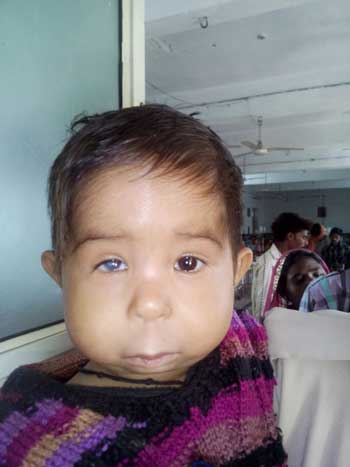|
|
|
Indian Pediatr 2015;52: 993 |
 |
Oculo-facio-cardio Dental Syndrome
|
|
*Ajay Gaur and Sakshi Ojha
Department of Pediatrics, GR Medical College, Gwalior,
MP, India.
Email: * [email protected]
|
|
Oculofaciocardiodental syndrome (OFCD) is a rare genetic disorder
affecting ocular, facial, dental and cardiac systems [1]. The genetic
analysis of OFCD patients revealed mutations in the BCOR (BCL-6
interacting co repressor) gene on chromosome Xp11.4 [1]. It has been
suggested that OFCD is an X- linked dominant trait [2], and embryonic
lethality for males [1]. Till date, very few cases have been reported
worldwide [3]. We present a female child diagnosed with minor features
of OFCD syndrome, suggesting that OFCD syndrome may be mild or
underdiagnosed.
 |
|
Fig. 1: Long and narrow face,
cataract and microphthalmia in right eye, long philtrum, pointed
nose and retrognathia in oculo-facio-cardio dental syndrome.
|
A 3-yr-old girl presented with complaints of fever,
cough and cold with severe anemia. She was born out of a non-consanguinous
marriage with no history of abortions or stillbirths in the mother.
Facial features suggested a long and narrow face, micrognathia, long
philtrum, retrognathia, and a pointed nose. On oral examination, she had
a high arched palate, maloccluded and malaligned teeth, radiculomegaly
and delayed dentition. Ophthalmic examination was suggestive of micro-phthalmia
and a congenital cataract in right eye. Chest X-ray was
suggestive of cardiac enlargement and 2-D echocardiography confirmed
patent ductus arteriosus. The girl had a nasal twang of voice suggesting
possibility of velopharyngeal insufficiency. She had a short stature
(weight-for-height <–3SD), but the developmental milestones were
appropriate for age with no intellectual disability. None of the family
member had any similar faciodental features.
Although, these features (in isolation) may be seen
in a variety of other conditions, OFCD is one of the few rare
craniofacial or dental disorders where the genetic cause is known and
the mode of action of the mutant gene is fairly well studied [1]. The
phenotypic and genotypic confirmation may lead to early identification,
and may thus prevent fatal outcomes.
References
1. Davoody A, Chen IP, Nanda R, Uribe F,
Reichenberger EJ. Oculofaciocardiodental syndrome: A rare case and
review of the literature. Cleft Palate Craniofac J. 2012;49:e55-60.
2. Hedera P, Gorski JL. Oculo-facio-cardio-dental
syndrome: Skewed X chromosome inactivation in mother and daughter
suggest X-linked dominant Inheritance. Am J Med Genet A.
2003;123A:261-6.
3. Verma G, Singh GK, Tandon P, Verma SL. A rare
syndrome with unusual dental findings: Oculo-facio-cardio-dental
syndrome. J Oral Maxillofac Pathol. 2014;18:331.
|
|
|
 |
|

